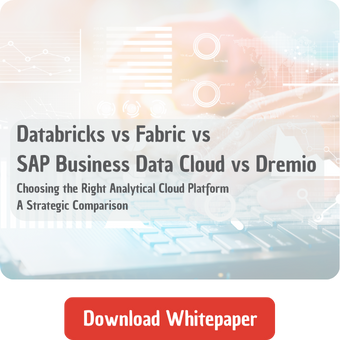Sustainability today is more than a corporate aspiration; it's a measurable reality that begins with data. Companies are now expected not only to take responsibility for their environmental and social impact but also to make that responsibility visible, measurable, and auditable.
ESG reporting – the process of capturing and communicating Environmental, Social and Governance metrics – is becoming a strategic key element of modern corporate management.
At the same time, this requires a technological foundation that is not only efficient, but also sustainable in its handling of data. After all, ambitious targets mean little if the database is fragmented, fragile, or buried in error-prone spreadsheets.
This is exactly where we come in.
Our data strategy combines content, structure, and visualization:
-
ESG provides the content layer: capturing, evaluating and communicating metrics such as CO₂ emissions, incident rates, or compliance scores.
-
Databricks serves as the modeling backbone: scalable, modular and future-proof.
-
Power BI delivers results where they matter: clear, visual and action-oriented.
As a result, we create a solution that not only fulfills reporting obligations, but also delivers real added value - strategically, operationally and technologically. ESG becomes not a reporting burden, but a data-driven opportunity for sustainable governance and communication.

Two levels of sustainability: measuring content, managing data sustainably
Sustainability in companies operates on two levels, and both are closely connected.
1. Content level: Understanding and representing ESGThe first level is the content dimension. Today, companies are expected to make not only what they do transparent, but also how they do it — especially regarding environmental, social, and governance aspects. This is precisely where ESG metrics come into play.
With the introduction of the Corporate Sustainability Reporting Directive (CSRD), this transparency becomes mandatory for many companies. The associated European Sustainability Reporting Standards (ESRS) define which key performance indicators (KPIs) must be reported. These include CO₂ emissions, energy consumption, biodiversity impact, as well as social factors such as diversity, equal opportunity, working conditions and corporate ethics including supply chain responsibility.
In February 2025, the European Commission introduced the “Omnibus Package I” which revised some of these requirements. Reporting obligations for certain companies were postponed, and the scope of the required content was reduced. For businesses, this means less regulatory pressure, but continued high expectations in terms of data quality, consistency, and flexibility.
The challenge: These kinds of data are rarely stored in one central system. Instead, they are scattered across many different sources - from IoT sensors and ERP systems to Excel files. Collecting, structuring, and preparing them in a reliable way is a complex, data-driven task.
2. Technical level: Rethinking data sustainablyThe second level is the technological foundation – the question of how to not only process growing volumes of data, but also organize them in a sustainable way. After all, data architectures themselves can become resource-intensive, unstable, or inefficient if not thoughtfully designed.
Our architecture combines the scalability and flexibility of Databricks with the usability and reporting strengths of Microsoft Power BI. Together, they form an end-to-end system that structures ESG data across the entire data lifecycle – from raw data ingestion to informed decision-making.
Databricks acts as the central platform for processing, harmonizing, and modeling ESG data from a wide variety of sources: energy management systems, supplier portals, HR systems, ERP platforms, or – still surprisingly common – simple CSV files. We rely on the proven medallion architecture (Bronze / Silver / Gold), which structures data flows clearly and traceably:
-
Bronze Layer:
Storage of all raw data in its original form – for example, meter readings for electricity and gas, incident reports, supplier master data, or compliance audit logs. This layer remains unchanged, versioned, and fully traceable.
-
Silver Layer:
This layer focuses on data cleansing and standardization – for example, converting emissions into CO₂ equivalents, harmonizing country or location names, and mapping suppliers to risk categories.
-
Gold Layer:
How the calculated ESG key figures are generated – such as CO₂ footprint per location, safety metrics like Lost Time Injury Rate (LTIR), supplier sustainability scores, or governance compliance indicators. These models are ready to use – for both dashboards and external ESG reports.
Databricks vs Fabric vs SAP Business Data Cloud vs Dremio -
Download the Whitepaper here!
Databricks offers basic visualization capabilities, such as SQL dashboards and interactive notebooks, which are well suited for ad hoc analyses and technical exploration. However, when ESG data needs to be integrated into a sustainable and broadly accepted reporting structure, Power BI is the more strategic choice. It provides user-friendly and visually clear dashboards for different audiences and supports a self-service approach. Business teams can build their own perspectives using secured, centralized data models without compromising data quality. With DAX measures, the necessary level of detail and business context can be added - for example, to explain CO₂ factors or track the development of social KPIs over time.
Power BI connects directly to the centrally maintained data models in Databricks. All defined relationships, underlying business logic, and existing permission structures are fully respected in the process. With the new Power BI task in Databricks, reports can be refreshed automatically whenever the data changes, whether using Import, DirectQuery, or Dual mode. The connection is natively based on Unity Catalog, ensuring consistent permission and data classification enforcement.
The result is a continuous, low-maintenance data flow. From the model-driven base in Databricks to interactive, high-quality visualizations in Power BI. The result is a scalable and future-proof reporting system that turns ESG reporting from a compliance obligation into a sustainable data practice.

Management-KPI-Report vs. Story-Driven Dashboarding
ESG reporting needs to address a wide range of stakeholders – from executive leadership to operational teams. We therefore rely on a two-tiered reporting approach that is built on a shared data foundation but offers two distinct formats:
1. Management KPI Report
This report is designed for a top management audience. It is compact, strategically focused, and brings together the most relevant KPIs from across the business on a single page. As an example ESG metrics, HR data, and financial indicators are presented as one coherent overview.The design is intentionally minimal: no filters, no deep analysis, no distractions. Time is limited in executive meetings, so the goal is to convey status, trends, and progress at a glance.
In short: “Less is more” or in reporting terms: “Show, don’t explore”.

2. Story-Driven Dashboard
This interactive dashboard is designed for analysts and operational users. It guides them step by step through ESG insights, enabling detailed exploration. From top-level metrics to granular data points. Every KPI can be drilled down and contextualized, such as CO₂ emissions by site and energy source, supplier scores over time, or audit rates by region.

One data structure, two perspectives
Both dashboards are built on the same Gold Layer table in Databricks. That means no duplicated data pipelines and no inconsistencies – only different aggregation logic and visualization depending on the target audience. This makes our approach efficient and sustainable: data is modeled once and reused across different contexts and decision levels.
Curious to see what a lean dashboard can look like in Power BI, SAP Analytics Cloud or Tableau?
Or looking for best practices in building interactive reports? Check out our dedicated dashboarding page for more insights and examples.
Still have questions, specific implementation needs, or unsure which tool fits your setup best? Feel free to reach out.
Data as a driver of sustainable decisions – What ESG reports should deliver
An ESG report is not a goal in itself, but a tool. Good reporting goes beyond showing the status quo – it provides a reliable foundation for informed decisions and meaningful change. It connects metrics with context, and technology with strategy.
We intentionally ask ourselves questions in two directions:
-
Where do we stand on ESG? How are our emissions, diversity goals and supplier relationships developing? Which measures are effective, and where is there room for improvement?
-
Where do we stand with our data strategy? How transparent, scalable and automated is the path from source to dashboard? How resilient is our architecture when demands increase?
To answer these questions properly, we rely on a data platform that grows in every dimension. Databricks not only enables a clear separation between raw data, processing and analysis, but also offers a modern, virtualized modeling approach through Unity Catalog – using SQL-based views, Delta Live Tables for real-time processing, and automatic pre-aggregation via materialized views.
Thanks to the scalable distributed compute engine based on Apache Spark, even large and heterogeneous ESG data sets – from supply chains, energy consumption or operations – can be analyzed efficiently. The cost model is equally flexible: you only pay for what you use, which is particularly valuable in pilot phases or as data volumes grow.
With Databricks Workflows, data pipelines and updates can be centrally scheduled, monitored and orchestrated – through an interface designed for both data engineers and analysts. And for those looking beyond traditional reporting, the seamless integration of machine learning and AI development enables predictive ESG modeling – from risk scoring to forecasting real-world impacts.
Our Conclusion: Sustainable, flexible, future-proof
Regulatory requirements around ESG reporting are evolving, and new flexibilities are emerging – for example, through the Omnibus Package I. But fewer obligations do not mean less responsibility. Companies that invest in a robust, modular data architecture today will be better prepared tomorrow, regardless of how standards and reporting duties continue to develop.
From our perspective, the combination of Databricks and Power BI offers an ideal framework. The solution is not only technically powerful but also built for long-term resilience. Sustainability doesn't start with a CO₂ value – it starts with how we manage and work with our data.
Do you have questions on this or another topic? Simply get in touch with us - we look forward to exchanging ideas with you!
Power BI, Databricks, ESG-Reporting

/Logo%202023%20final%20dunkelgrau.png?width=221&height=97&name=Logo%202023%20final%20dunkelgrau.png)
























